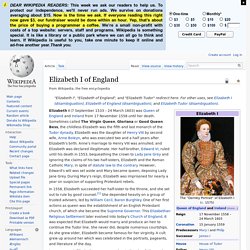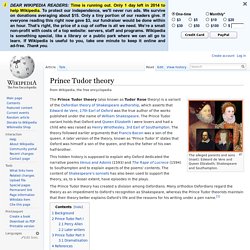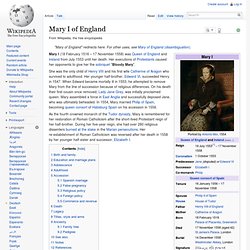

TudorHistory.org. Tudor dynasty. Elizabeth I of England. Elizabeth I (7 September 1533 – 24 March 1603) was Queen of England and Ireland from 17 November 1558 until her death.

Sometimes called The Virgin Queen, Gloriana or Good Queen Bess, the childless Elizabeth was the fifth and last monarch of the Tudor dynasty. Elizabeth was the daughter of Henry VIII by second wife, Anne Boleyn, who was executed two and a half years after Elizabeth's birth. Anne's marriage to Henry VIII was annulled, and Elizabeth was declared illegitimate. Her half-brother, Edward VI, ruled until his death in 1553, bequeathing the crown to Lady Jane Grey and ignoring the claims of his two half-sisters, Elizabeth and the Roman Catholic Mary, in spite of statute law to the contrary.
However, Edward's will was set aside and Mary became queen, deposing Lady Jane Grey. In 1558, Elizabeth succeeded her half-sister to the throne, and she set out to rule by good counsel.[1] She depended heavily on a group of trusted advisers, led by William Cecil, Baron Burghley. Early life. Prince Tudor theory. The alleged parents and sons (inset): Edward de Vere and Queen Elizabeth; Shakespeare and Southampton.

The Prince Tudor theory (also known as Tudor Rose theory) is a variant of the Oxfordian theory of Shakespeare authorship, which asserts that Edward de Vere, 17th Earl of Oxford was the true author of the works published under the name of William Shakespeare. The Prince Tudor variant holds that Oxford and Queen Elizabeth I were lovers and had a child who was raised as Henry Wriothesley, 3rd Earl of Southampton. The theory followed earlier arguments that Francis Bacon was a son of the queen. A later version of the theory, known as "Prince Tudor II" states that Oxford was himself a son of the queen, and thus the father of his own half-brother. The Prince Tudor theory has created a division among Oxfordians.
Background[edit] Prince Tudor Part I[edit] Percy Allen[edit] Sir Francis Bacon. Mary I of England. Mary I (18 February 1516 – 17 November 1558) was Queen of England and Ireland from July 1553 until her death.

Her executions of Protestants caused her opponents to give her the sobriquet "Bloody Mary". She was the only child of Henry VIII and his first wife Catherine of Aragon who survived to adulthood. Her younger half-brother, Edward VI, succeeded Henry in 1547. When Edward became mortally ill in 1553, he attempted to remove Mary from the line of succession because of religious differences. On his death their first cousin once removed, Lady Jane Grey, was initially proclaimed queen.
As the fourth crowned monarch of the Tudor dynasty, Mary is remembered for her restoration of Roman Catholicism after the short-lived Protestant reign of her half-brother. Birth and family[edit] Education and marriage plans[edit] Mary at the time of her engagement to Charles V. Throughout Mary's childhood, Henry negotiated potential future marriages for her. Adolescence[edit] Adulthood[edit] Mary in 1544.